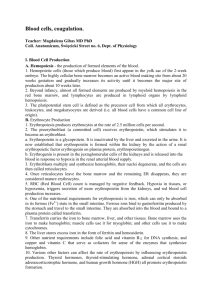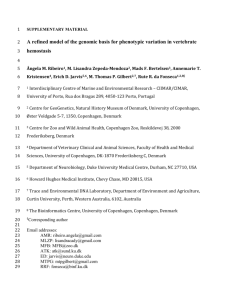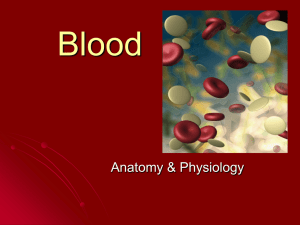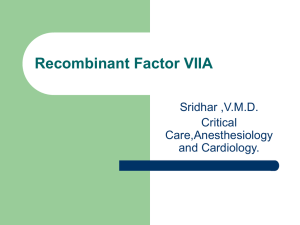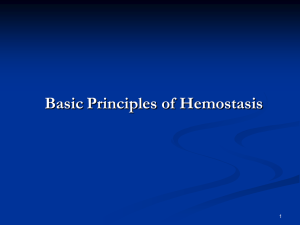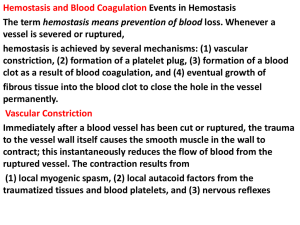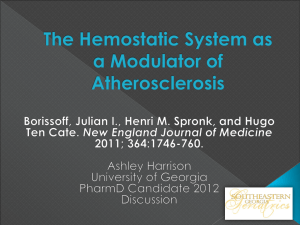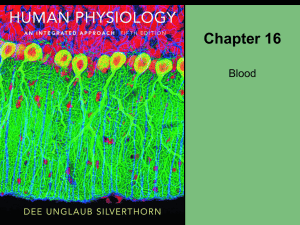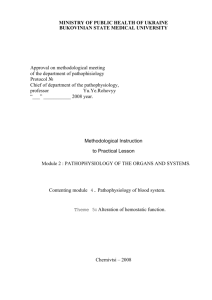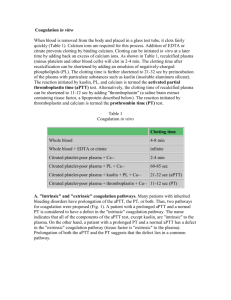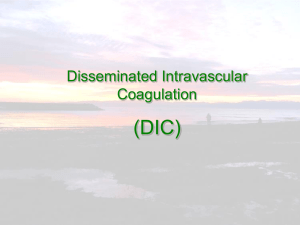I. Blood Cell Production
advertisement
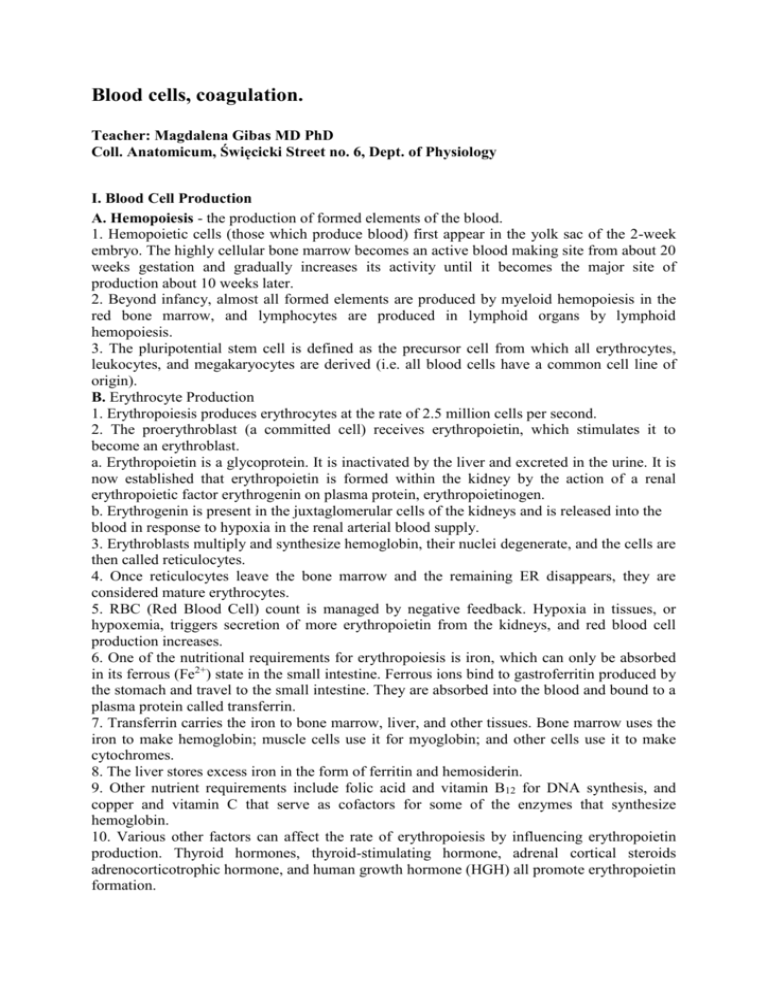
Blood cells, coagulation.
Teacher: Magdalena Gibas MD PhD
Coll. Anatomicum, Święcicki Street no. 6, Dept. of Physiology
I. Blood Cell Production
A. Hemopoiesis - the production of formed elements of the blood.
1. Hemopoietic cells (those which produce blood) first appear in the yolk sac of the 2-week
embryo. The highly cellular bone marrow becomes an active blood making site from about 20
weeks gestation and gradually increases its activity until it becomes the major site of
production about 10 weeks later.
2. Beyond infancy, almost all formed elements are produced by myeloid hemopoiesis in the
red bone marrow, and lymphocytes are produced in lymphoid organs by lymphoid
hemopoiesis.
3. The pluripotential stem cell is defined as the precursor cell from which all erythrocytes,
leukocytes, and megakaryocytes are derived (i.e. all blood cells have a common cell line of
origin).
B. Erythrocyte Production
1. Erythropoiesis produces erythrocytes at the rate of 2.5 million cells per second.
2. The proerythroblast (a committed cell) receives erythropoietin, which stimulates it to
become an erythroblast.
a. Erythropoietin is a glycoprotein. It is inactivated by the liver and excreted in the urine. It is
now established that erythropoietin is formed within the kidney by the action of a renal
erythropoietic factor erythrogenin on plasma protein, erythropoietinogen.
b. Erythrogenin is present in the juxtaglomerular cells of the kidneys and is released into the
blood in response to hypoxia in the renal arterial blood supply.
3. Erythroblasts multiply and synthesize hemoglobin, their nuclei degenerate, and the cells are
then called reticulocytes.
4. Once reticulocytes leave the bone marrow and the remaining ER disappears, they are
considered mature erythrocytes.
5. RBC (Red Blood Cell) count is managed by negative feedback. Hypoxia in tissues, or
hypoxemia, triggers secretion of more erythropoietin from the kidneys, and red blood cell
production increases.
6. One of the nutritional requirements for erythropoiesis is iron, which can only be absorbed
in its ferrous (Fe2+) state in the small intestine. Ferrous ions bind to gastroferritin produced by
the stomach and travel to the small intestine. They are absorbed into the blood and bound to a
plasma protein called transferrin.
7. Transferrin carries the iron to bone marrow, liver, and other tissues. Bone marrow uses the
iron to make hemoglobin; muscle cells use it for myoglobin; and other cells use it to make
cytochromes.
8. The liver stores excess iron in the form of ferritin and hemosiderin.
9. Other nutrient requirements include folic acid and vitamin B12 for DNA synthesis, and
copper and vitamin C that serve as cofactors for some of the enzymes that synthesize
hemoglobin.
10. Various other factors can affect the rate of erythropoiesis by influencing erythropoietin
production. Thyroid hormones, thyroid-stimulating hormone, adrenal cortical steroids
adrenocorticotrophic hormone, and human growth hormone (HGH) all promote erythropoietin
formation.
C. Leukocyte Production
1. Leukopoiesis is the production of white blood cells; it begins when hemocytoblasts
differentiate into three types of cells: B progenitors, T progenitors, or granulocytemacrophage colony-forming units.
2. A variety of hormones stimulate the production of specific types of leukocytes in response
to specific needs of the body.
3. Granulocytes and monocytes are stored in red bone marrow and released when needed.
Lymphocytes begin developing in bone marrow, then migrate to lymphoid tissue to mature.
D. Platelet Production
1. Platelet production (thrombopoiesis) begins when a hemocytoblast becomes a
megakaryoblast. In response to thrombopoietin, the megakaryoblast develops into a huge
megakaryocytic. Some of the megakaryocytic fragments become functional platelets.
II. Erythrocytes
A. Form and Function
1. The biconcave shape increases the cell's surface area and facilitates diffusion of O2 and
CO2 into or out of the cell; the lack of nuclei and organelles contribute to increased
haemoglobin content.
2. Their function is to:
a. carry respiratory gases
b. work as a buffer (Remember respiration? See biochemistry!!!)
2. Normal erythrocytes must be very flexible. They become deformed when flowing through
capillaries and narrow slits in the spleen. All red blood cells have a limited life span of around
100 to 120 days. Aged RBC's are removed by the spleen, liver and the bone marrow.
3. Normal adult ranges: men 4.5 – 6.0 T/L; women 3.8 – 5.2 T/L
B. Hemoglobin
1. Hemoglobin consists of four protein chains called globins. Two are alpha chains, and two
are beta chains. Each chain is conjugated with a nonprotein heme group that binds oxygen to a
ferrous ion at its center.
2. Carbon dioxide is transported bound to the globin portion of the hemoglobin.
3. Hemoglobin exists in several forms that differ in their structure and oxygen-carrying
capacity. Fetal hemoglobin has a higher oxygen-binding capacity than adult hemoglobin, and
thus can extract oxygen from the mother's blood.
4. The hemoglobin concentration is 13–17 g/dL in men, and 12–16 g/dL in women.
5. This difference between the sexes exists because male androgens stimulate RBC
production, women have menstrual cycles, and hematocrit is inversely proportional to body
fat, which is usually higher in women.
C. Erythrocyte Disorders
1. Polycythemia is an excess of red blood cells.
a. Primary polycythemia is due to cancer of the myeloid tissue.
b. Secondary polycythemia is caused by lung damage, high altitude, or other factors leading to
hypoxia.
c. Polycythemia is dangerous mostly because of the increased blood viscosity.
2. Anemia is a deficiency of either RBCs or hemoglobin.
a. Anemia falls into three categories: inadequate erythropoiesis or hemoglobin production
(usually due to a nutritional deficiency), hemorrhagic anemia from bleeding, and hemolytic
anemia from red blood cell destruction.
b. Three potential consequences of anemia are hypoxia, reduced blood osmolarity, and
reduced blood viscosity.
3. Sickle-cell disease and thalassemia are hereditary disorders affecting hemoglobin.
III. Leukocytes
A. Leukocytes (white blood cells, or WBCs) play a role in the body's immune response.
1. WBCs are less numerous than RBCs, and most are short-lived.
2. There are five main types of white blood cells (Schilling’s count):
neutrophils 45 - 65 %
eosinophils 1-4 %
basophils 0.5-1%
lymphocytes 20 - 40 %
monocytes 3 - 8 %
3. Some are called granulocytes (the neutrophils, eosinophils, and basophils) because of their
granular appearance. Agranulocytes (lymphocytes and monocytes) do not appear granular.
B. Types of Leukocytes
1. Granulocytes are distinguished from each other by the properties of their cytoplasmic
granules.
a. Neutrophils have fine granules that contain antimicrobial agents. They have lobed nuclei,
and function in the phagocytosis of bacteria and release of antimicrobial agents.
The cytoplasm of neutrophils contains three types of granules:
primary granules are non-specific and contain lysosomal enzymes, defensins,
and some lysozyme. The granules are similar to lysosomes. The enzymes
produce hydrogen peroxide which is a powerful anti-bacterial agent.
secondary granules are specific to neutrophils and stain light pink ('neutral
stain'). They contain collagenase, to help the cell move through connective
tissue, and lactoferrin, which is toxic to bacteria and fungi.
tertiary granules have only recently been recognised. It is thought that they
produce proteins which help the neutrophils to stick to other cells and hence
aid the process of phagocytosis.
b. Eosinophils have cytoplasmic granules that stain orange-pink with eosin dye. The nucleus
is bilobed. Eosinophils phagocytize antigen-antibody complexes, allergens, and inflammatory
chemicals, and they aggregate near parasites and release enzymes to destroy them.
c. Basophils have a U- or S-shaped nucleus and coarse granules that stain purple with basic
dye. Basophils release histamine (a vasodilator) and heparin (an anticoagulant), thereby
increasing blood flow into an area and promoting the mobility of other WBCs.
2. Types of agranulocytes are lymphocytes and monocytes.
a. Lymphocytes are only slightly larger than RBCs and have a rounded nucleus. They secrete
antibodies (B cells), destroy foreign or cancer cells (T cells), or secrete chemicals to enhance
the functions of other immune cells (helper T cells).
b. Monocytes are the largest of the formed elements, with variably shaped nuclei and clear
cytoplasm. These cells differentiate into macrophages that, in turn, phagocytize foreign
particles and debris and activate other cells of the immune system.
C. Abnormalities of Leukocyte Count
1. Total WBC count is usually 4,000 to 11,000 per mm3. A count less than this (leukopenia)
can result from toxic chemicals, drugs, or certain diseases.
2. A higher than average count (leukocytosis) indicates an infection, allergy, dehydration, or
emotional disturbance.
3. A more useful count is a differential WBC count, which identifies the relative abundance of
each type of white cell. A high neutrophil count indicates a bacterial infection, such as might
occur with appendicitis, for example. Numerous eosinophils indicate allergies or parasites.
4. An extraordinarily high number of WBCs is characteristic of leukemia, or cancer of the
hemopoietic tissues.
IV. Hemostasis - The Control of Bleeding
A. Hemostasis is the stoppage of bleeding, the mechanisms for which are most effective in
the smaller vessels. Platelets play multiple roles in hemostasis.
B. Platelets
1. Platelets are cell fragments having pseudopods that make amoeboid motion possible. They
are also phagocytic. Normal counts range from 150,000 to 400,000 per mm3.
2. Platelets secrete growth factors that stimulate mitosis in fibroblasts and smooth muscle, and
help maintain linings of blood vessels.
3. Platelets secrete vasoconstrictors that cause vascular spasms in broken vessels.
4. They may secrete chemicals that attract neutrophils and monocytes to inflamed areas.
5. They dissolve blood clots that have outlasted their usefulness.
C. Vascular Spasm
1. Vascular spasm is the prompt constriction of a broken vessel to help stop bleeding. It is
triggered by nervous impulses (pain pathway), by injury to the smooth muscle within the
vessel wall, and by serotonin (a vasoconstrictor) from platelets.
2. Vascular spasm can usually be maintained long enough for platelet plug formation and
coagulation to have an effect.
D. Platelet Plug Formation
1. When a vessel is injured, collagen fibers in its wall are exposed, causing platelets to stick to
them.
2. As more platelets join in, a platelet plug forms that can stop minor bleeding.
3. Platelets undergo degranulation as they aggregate, releasing substances that promote
hemostasis.
E. Coagulation - classical model
1. Coagulation is the most effective method of hemostasis and the most complex, involving
over 30 chemical reactions.
2. The objective of coagulation is to convert soluble fibrinogen into insoluble fibrin. As
this occurs, blood cells and platelets get stuck in the net of fibrin, stopping blood loss.
3. The two reaction pathways to coagulation are the extrinsic mechanism, initiated by
chemicals released from damaged tissue, and the intrinsic mechanism, initiated by factors
within the vessel itself, such as clots.
4. Clotting factors are called procoagulants and are produced in the liver. They normally
circulate with the plasma in inactive form. The coagulation factors are numbered in the order
of their discovery. The liver must be able to use Vitamin K to produce Factors II, VII, IX, and
X. Dietary vitamin K is widely available from plant and animal sources. It is also produced by
normal intestinal flora. A deficiency is rare but may occur:
- in newborns because they must first develop normal flora to produce Vitamin K, or
-when the flora is disturbed by broad-spectrum antibiotics.
5. One clotting factor activates the next, which in turn activates another factor, and so on, in a
reaction cascade.
6. In the initiation of coagulation for the extrinsic mechanism, damaged tissue releases tissue
thromboplastin that, along with calcium ions, activates the next step in the chain. The cascade
of enzymatic reactions acts like an amplifying mechanism to ensure rapid clotting.
7. In the completion of coagulation, once factor X is activated, the sequence of events is the
same for both the extrinsic and intrinsic mechanisms.
a. Factor X combines with factors III and V (with calcium and PF3) to produce prothrombin
activator, which next works on prothrombin and converts it to thrombin.
b. Thrombin converts fibrinogen to fibrin.
c. Normally, a fingerstick should stop bleeding within 2–3 minutes, but massaging the area to
release more tissue thromboplastin should accelerate the process.
The clotting cascades: The intrinsic cascade is initiated when contact is made between blood
and exposed endothelial cell surfaces. The extrinsic pathway is initiated upon vascular injury
which leads to exposure of tissue factor (TF) (also identified as factor III), a subendothelial
cell-surface glycoprotein that binds phospholipid. The green dotted arrow represents a point
of cross-over between the extrinsic and intrinsic pathways. The two pathways converge at the
activation of factor X to Xa. Factor Xa has a role in the further activation of factor VII to VIIa
as depicted by the green arrow. Active factor Xa hydrolyzes and activates prothrombin to
thrombin. Thrombin can then activate factors XI, VIII and V furthering the cascade.
Ultimately the role of thrombin is to convert fribrinogen to fibrin and to activate factor XIII to
XIIIa. Factor XIIIa (also termed transglutaminase) cross-links fibrin polymers solidifying the
clot. HK = high molecular weight kininogen. PK = prekallikrein. PL = phospholipid.
F. Coagulation – cell-based model (The new model of haemostasis)
1. Although the classical model of coagulation supports laboratory tests of coagulation
disorders, it does not adequately explain the mechanisms leading to haemostasis in vivo. In
particular, it does not explain why certain patients demonstrate a haemorrhagic tendency; nor
does it allow accurate prediction of which patients will actually bleed.
2. A cell-based model of haemostasis has been developed which will replace the classical
model of the coagulation cascade. Research has shown that haemostasis occurs on different
cell surfaces in three overlapping steps: initiation, amplification and propagation.
- the first phase, or initiation, occurs on a tissue factor (TF)-bearing cell
- in the amplification phase, platelets and co-factors are activated in order to prepare for
large-scale thrombin generation.
- finally, propagation occurs on the surface of platelets, and results in the propagation of
large amounts of thrombin.
3. The research, which has led to the development of the cell-based model, is the work of
Dr Maureane Hoffman’s team, Department of Pathology, Duke University Medical
Center, USA.
G. Tests of coagulation
1. Whole blood clotting time – norm: 4-10 min.
2. Prothrombin test (PT) – norm: 11 to15 seconds. A prolonged prothrombin time indicates
a deficiency in any of factors VII, X, V, prothrombin (factor II), or fibrinogen (factor I). It
may mean that the patient has:
- a vitamin K deficiency (vitamin K is a co-factor in the synthesis of functional factors
II (prothrombin), VII, IX and X)
- a liver disease (the liver is the site of synthesis of the plasma protein factors)
- PT of patients receiving a vitamin K-competing coumarin drug such as warfarin
(anticoagulation therapy used in deep venous thrombophlebitis) will also be prolonged
3. International normalized ratio (INR) - The result for the prothrombin time is expressed
as a ratio (clotting time for patient plasma divided by time for control plasma); Application:
Monitoring oral anticoagulant therapy (warfarin therapy). Heparin does not prolong the
INR, since heparinase is included within the INR reagent.
4. Activated Partial Thromboplastin Time test (aPTT) – norm: 25 to 35 seconds.
Application: Inappropriate as a routine preoperative screening test, due to its limited
sensitivity and specificity. Used as an initial test when the personal and/or family history
suggests a coagulation factor deficiency or when the history suggests a coagulation factor
inhibitor or a lupus inhibitor. Prolongation of aPTT:
- an isolated prolongation of the APTT (PT normal) suggests deficiency of factor
VIII, IX, XI or XII
- prolongation of both the APTT and PT suggests factor X, V, II or I (fibrinogen)
deficiency, all of which are rare.
- APTT is normal in factor VII deficiency (PT prolonged) and factor XIII deficiency
- prolonged APTT which is not corrected by the in vitro addition of normal plasma
suggests a coagulation factor (VIII or IX) inhibitor or a lupus inhibitor.
5. Bleeding time – norm: 1 to 9 min (finger method) or 1-4 min (ear lobe method).This is
a simple test of platelet function. It is abnormal in von Willebrand's disease and may be
prolonged by aspirin or NSAIDs therapy.
H. The Fate of Blood Clots
1. After a clot forms, it undergoes clot retraction within 30 minutes.
2. Platelets and endothelial cells secrete a stimulant causing fibroblasts and smooth muscle
cells to multiply and repair the damaged vessel. Fibroblasts invade and strengthen the clot.
3. When tissue repair is completed, the clot is dissolved by fibrinolysis. This process involves
a cascade of reactions, ending in the production of plasmin, a fibrin-dissolving enzyme.
G. Prevention of Inappropriate Coagulation
1. Controls are required to prevent unnecessary coagulation. These include platelet repulsion,
dilution, and anticoagulants such as antithrombin and heparin.
2. Mechanisms of anticoagulants and firbinolytic agents action (warfarin, heparin, aspirin,
streptokinase).
